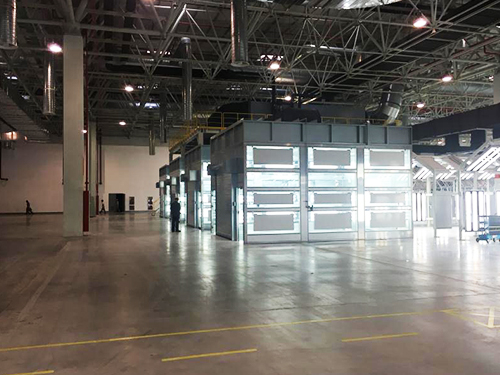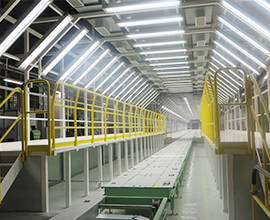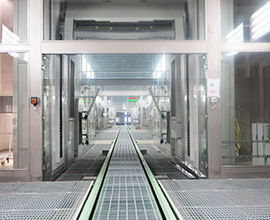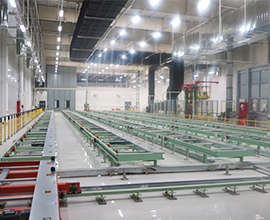
Automotive Industry Sewage Treatment
- Categories:January
- Author:
- Origin:
- Time of issue:2013-01-30 08:50
- Views:
(Summary description)HC surface treatment network: coating process is widely used in automotive surface treatment, and there are basically wastewater generated in the production process
Automotive Industry Sewage Treatment
(Summary description)HC surface treatment network: coating process is widely used in automotive surface treatment, and there are basically wastewater generated in the production process
- Categories:January
- Author:
- Origin:
- Time of issue:2013-01-30 08:50
- Views:
HC surface treatment network: coating process is widely used in automotive surface treatment, and there are basically wastewater generated in the production process [1], and the treatment of automotive coating wastewater has become a major problem in today's sewage treatment project. to be solved. Through years of exploration and engineering practice, it has been found that the use of physicochemical + biochemical treatment of automotive coating wastewater is cost-effective, but there are also some problems in practical applications, which need to be optimized and improved to make automotive coating wastewater treatment more Stable and effective.
1 Source and characteristics of automotive coating wastewater
The wastewater generated in the coating process mainly includes pre-treatment degreasing, pickling and phosphating, such as pre-treatment wastewater, electrophoretic coating wastewater and spray paint wastewater when spraying bottom, medium and topcoat [2]. The composition of each batch of wastewater is complex, the concentration is different, and the treatment is difficult.
In addition to the continuous overflow of part of the washing water from the water tank, the wastewater or waste liquid generated in each process is mostly intermittently discharged, and the mixed wastewater forms a high turbidity coating wastewater. The water volume and water quality of the wastewater vary within one day. It is very large and has no regularity. The pollutants in the wastewater are complex and contain a variety of toxic substances. The concentration is high and the biodegradability is poor. After years of monitoring, the comprehensive water quality is: CODcr concentration 1000~2500mg/L, BOD5 concentration 100~250mg/L, SS concentration 400~600mg/L, petroleum concentration 30~85mg/L, phosphate concentration 25~50mg /L, pH
7.0 to 8.5, Zn2+ concentration 5.0 to 20 mg / L.
2 treatment process research
2.1 Simple materialization method
Due to the poor biodegradability of automotive coating wastewater, the simple physicochemical treatment process is generally: conditioning tank - coagulation sedimentation or air flotation - sand filtration - activated carbon filtration, and some processes separate the wastewater from each process. The respective dosing reactions are pretreated (such as oily wastewater, and the drug is demulsified), followed by coagulation sedimentation or air flotation. By selecting an appropriate coagulant and flocculant, it is theoretically feasible to treat the coated wastewater. However, the water quality of the effluent is not stable after the simple physical treatment. After the coagulation sedimentation or air flotation, the COD removal rate is 30% to 60%, and the highest is 80%, that is, the effluent COD will be around 450mg/L. Most of them are organic substances that are soluble in water. The removal of this part of organic matter is mainly caused by the adsorption of activated carbon, which increases the load of the activated carbon filter, and quickly disables the activated carbon, thereby causing the water to fail to reach the standard. At the same time, the process flow is long, the operation and maintenance are complicated, and the running cost is high.
2.2 Physicochemical + biochemical combination processing method
At present, one of the most promising methods for treating automotive coating wastewater is physicochemical + biochemical method. The core principle of this process is: using physicochemical method as pretreatment, and then using biochemical treatment to stabilize the wastewater.
(1) Physical and chemical pretreatment
Since the automobile coating wastewater contains a large amount of substances such as phosphate which cannot be completely removed or difficult to remove, it must be removed by physicochemical method. In the actual project, lime is mostly used, and the pH value of the wastewater is controlled to be above 11.5 by using lime milk, so that the phosphate and zinc ions are formed to form hydroxyapatite and zinc hydroxide precipitate, so that the phosphate concentration in the wastewater is lower than that. 5.0 mg/L. At the same time, Ca2+ is used to complete the colloidal destabilization and agglomeration process of the emulsified oil and polymer resin, which creates conditions for the coagulation reaction.
(2) Biochemical treatment
After the wastewater is pretreated by physicochemical method, the water quality is improved, but it must be treated by biochemical method before it can reach the standard. Because the main pollutants in the paint shop wastewater are poorly biodegradable (BOD/COD=0.1), improving the biodegradability of raw water is the primary condition for the biochemical treatment of the wastewater. Secondly, due to the imbalance of nutrients in industrial wastewater, it is necessary to add nutrient sources to improve the biochemical properties of wastewater. On the other hand, in the early stage of biochemical treatment, the wastewater is first subjected to hydrolysis and acidification treatment, that is, the anaerobic control is carried out in the hydrolysis and acidification stage, and the hydrolyzed acid bacteria are used to decompose synthetic organic substances such as epoxy resins and ethers. Broken chains such as aromatic organic compounds are decomposed into small molecular organic substances, thereby improving the biodegradability of wastewater.
After the wastewater is hydrolyzed and acidified, it is subjected to an aerobic process for subsequent treatment. The aerobic biochemical section is the core of the entire wastewater treatment process. Under aerobic conditions, the degradable pollutants in the wastewater are partially synthesized into microbial cells under the action of aerobic microorganisms, and the other part is decomposed into CO2 and H2O, which can be completely removed. Some of the excess microbial organisms are excluded from the system by sludge removal. In order to purify the water.
The aerobic processes that are used more in engineering practice include the SBR process and the contact oxidation process. Since the water quality and water quantity of automobile coating wastewater vary greatly, the contact oxidation method is difficult to operate stably, and the effluent water quality fluctuates greatly. It needs to be supplemented by micro-flocculation filtration or activated carbon adsorption, and the effluent can reach the standard stably. In the SBR process, the influent, aeration reaction, static precipitation, supernatant and idle phase cycle operation combines biological treatment and sedimentation. It has stable operation effect, water resistance and organic load impact, flexible operation and simple structure. It is easy to operate and maintain [4], so the SBR process is widely used in automotive coating wastewater.
2.3 Process
Taking the coating wastewater treatment of an automobile manufacturing company in Hunan as an example, the designed treatment water volume: Q=300m3/d, the water quality is as described above, and the process flow is as follows:
Due to the irregular pouring process in the coating pretreatment, the inverted tank waste liquid is intermittently discharged, the water volume is large, and the concentration is very high, and the mass separation and shunting treatment must be performed. The concentrated waste liquid is collected in the concentrated waste liquid tank; while the other low-concentration waste water enters the regulating tank, and then the concentrated waste liquid is periodically quantitatively pumped into the regulating tank by the pump, and fully mixed with other waste water; Lime milk and PAM are added to the condensing reaction tank, and most of the phosphate, heavy metal and SS are removed after thorough mixing reaction, and then precipitated and clarified, and hydrochloric acid is added to adjust the pH of the wastewater. After physicochemical treatment, the effluent enters the SBR pool after hydrolysis and acidification, and aerobic biochemical reaction is carried out in the SBR pool. The organic matter in the wastewater is decomposed by aerobic, so that the wastewater can be purified and reach the national first-class standard discharge.
3 process improvement
Through the design and actual operation of several automotive coating wastewater treatment plants, it is found that the treatment of coating wastewater by physicochemical + biochemical method is economically feasible and can achieve the expected treatment effect, but there are also some problems that need to be optimized and Improve.
3.1 uniform water quality
Since most of the automobile coating wastewater is intermittently discharged, the instantaneous discharge water volume is large and the concentration is high, and it must be uniformly mixed in the adjustment tank to reduce the impact on subsequent treatment. When designing the regulating tank, it is necessary to meet the sufficient time for the wastewater to stay in the tank to mix evenly. The effective volume of the general regulating tank accounts for more than 40% of the designed water volume. In operation, special attention must be paid to the safe volume in the tank to dilute the waste liquid from the inverted tank. The high-concentration waste liquid pumped in the pool prevents large fluctuations in water quality, resulting in the system not operating stably.
3.2 Control of chemical phosphorus removal
The concentration of phosphate in automotive coating wastewater is high, and physical phosphorus removal must be considered. Excess lime milk is added during operation to adjust the pH value of the wastewater to above 11.5 to remove heavy metal ions, which can be used as a cheap and efficient phosphorus removal agent. According to the actual operation, lime is used as a coagulant, PAM is a flocculant, the removal rate of phosphate can reach about 99%, and the effluent concentration is less than 0.5mg/L. However, such high-efficiency chemical phosphorus removal causes the phosphate in the wastewater to be too low, which affects the subsequent biochemical reaction. The dosage of the lime milk must be properly controlled to ensure that the concentration of phosphate in the effluent is within 2.0-3.0 mg/L. It can not only meet the needs of biochemical reactions, but also ensure the stability of the final effluent phosphate.
3.3 Supplementation of wastewater nutrients
Due to the lack of various nutrient sources required for microorganisms in automotive coating wastewater, nutrients for supplementing wastewater must be considered.
Scan the QR code to read on your phone
Latest News


In The First Quarter Of 2014, Hayden Seth Won The Contract For The General Contracting Project Of The Coating Workshop Of Jiangx

The Company Successfully Won The Bid For The Reconstruction And Expansion Of Shanghai Volkswagen CPH & CP5 Black Roof Coating Pr

The Company Signed A Strategic Cooperation Agreement With Beijing Industrial Design And Research Institute

Address: No. 520, Houdongzhou Village, Hengshan Town, Wujin District, Changzhou City
Tel:0086-519-83980153
Mobile:+86-13815473448
Fax:0086-519-83981158

Mobile Website
Copyright © 2022 ChangZhou Haden Process Engineering Co., Ltd. All Rights Reserved 苏ICP备13040250号-1 SEO

 0519-83980153
0519-83980153 

 Message
Message 